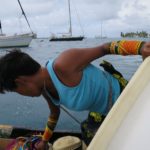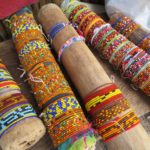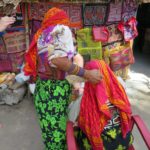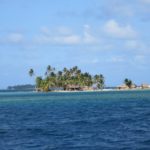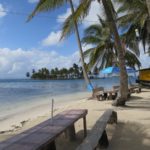There is something really incredible about seeing jewelry being made by hand in the tradition of the people who wear it themselves. On my recent visit to the San Blas islands, I was happy to find the local Kuna women making, wearing, and selling their woven bead designs in the same way they have done for years. The beads are tiny and colorful and sold on long strands that the woman wrap tightly around your wrists or ankles, threading a string between the beads through the middle to stitch it together. The San Blas region, called Kuna Yala by the local people, was one of the most beautiful areas I had ever visited as well as home to a unique jewelry tradition I was able to witness first hand.
The San Blas are an archipelago off the northern coast of Panama comprising approximately 365 islands and cays, (imagine a different island for every day of the year!) of which only 49 are inhabited. Many of the islands have only a single family living on them, and from what our sailboat captain explained, the tribal chief decides which families live on which islands and there is a system of rotation between families. The Kuna are an autonomous indiginous group who run San Blas with minimal interference from the national government. Because of this, to visit these untouched islands is an incredible experience and chance to see a protected region of the world where the inhabitants truly take care of the natural environment that is their home.
We sailed from Portobelo in Panama and arrived later that afternoon to the first island. We took the dinghy from our sailboat and visited a tiny island locals called Venadu (Frigata island according to a sign nailed to a palm tree). It consisted of a single thatched roof hut, a small shack serving beer, water and shellfish, and a few palm trees providing a bit of shade over some rustic wooden tables. The Kuna women had a small display of giant conch shells, beaded jewelry and colorful textile molas that they use for their clothing (the Kuna were encouraged to start wearing clothing by the Spanish missionaries, but previously had painted the colorful designs seen on molas directly onto the skin). I picked out one of the strands of beads and the Kuna woman in her colorful Mola had me sit down so she could wrap it for me. Most of the beads are $5 or $10 depending on how long the strands are, and once she started weaving a string through each bead, I realized it would not be coming off my ankle any time soon. The Kuna themselves have their arms and legs wrapped in layers of the beads often up to the elbows and knees.
Later that afternoon we were back on the sailboat when a small wooden canoe with two Kuna woman and a young girl came rowing up beside our boat. They were also selling the colorful bracelets and I decided I needed to have one more! Just as I was about to climb into our dinghy so that she could wrap my wrist, a huge rain cloud opened up on us and we all were drenched. Our captain invited the Kuna to climb onto our boat to escape the pelting rain. It was one of the best moments of the visit to San Blas. There I was, sitting on a sailboat quietly with the local women, surrounded by remote islands and blue seas and a tropical rain storm. We shared a single moment of mutual appreciation for a bit of relatively dry space. We waited, sat watching the rain, and for a few moments said nothing at all.

Here’s a video of the beads being wrapped!
Here is a link to an informative article about the reality of life in Kuna Yala.


